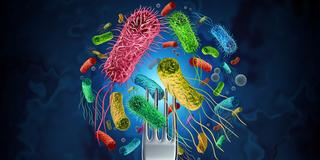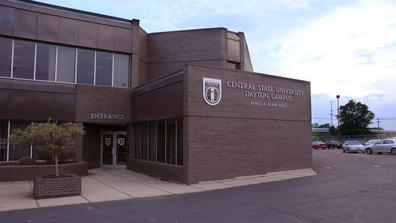
Foodborne pathogens: Six questions for the researcher


The United States has witnessed a significant increase in the consumption of fresh produce, fruit, and vegetables — a critical part of a healthy and balanced diet — in the last 25 years. This rise in fresh produce consumption has coincided with a spike in foodborne outbreaks and illnesses in the country.
Central State University Food Safety Research Professor Robert Korir, Ph.D., responds to a list of questions from Cyril Ibe on common foodborne pathogens, where they are found, and how to prevent and control them. Answers have been lightly edited for clarity.
Q: What are the most common foodborne pathogens, the source or sources, and the associated foods?
A: The following are some of the most common foodborne pathogens.
- Salmonella species: Salmonella are bacteria that can be found in food like chicken, beef, pork, eggs, fruit, vegetables, or processed food. The bacteria can be spread to people through contaminated water and environments and also can be carried and spread by animals, both domestic and wild, including even pets, or animals in zoos. According to the Centers for Disease and Prevention Center (CDC) outbreak reports, salmonella infections have been linked to peanut butter, packaged meats, frozen food, chicken, and produce. Salmonella bacteria cause about $1.35 million in infections per year in the U.S.
- Escherichia coli O157:H7 (E. coli 157:H7): E. coli O157: H7 bacteria is one of the pathogenic E. coli strains. It is mostly from warm-blooded mammals like cattle and gets onto produce and environment or water through manure and feces contamination.
- Listeria monocytogenes is a pathogenic bacterium that can be found in the natural environment and food-contact processing surfaces, and it causes listeriosis disease.
- Staphylococcus aureus: These are bacteria that are commonly found on the skin and in the noses of up to 25% of healthy people and animals. The bacteria can be passed by person-to-person contact or through food from improper food handling.
- Shigella species are bacteria that can be transmitted to people through exposure to feces, contaminated water, food, or surfaces.
- Vibrio vulnificus is a bacterium that is associated with uncooked or raw seafood (fish or shellfish) and oysters.
- Campylobacter species are bacteria that can be carried by poultry, cattle, and other animals that show no signs of illness.
- Clostridium botulinum is a bacterium that causes food poisoning called botulism. Botulism consists of spores most often contained in home-canned foods that have been improperly processed.
- Clostridium perfringens are bacteria known for living in high-protein foods. They can be found in the intestines of humans and animals. Common food sources of Clostridium perfringens include meat and poultry dishes, soups, and sauces, such as gravy.
- Norovirus: Norovirus is a leading cause of foodborne illnesses in the U.S. Feces and vomit are the commonly known sources of contamination in areas where food is grown or harvested, and the virus can spread through infected personnel handling food.
- Protozoa parasites: Cryptosporidium parvum, Giardia lamblia, Cyclospora cayetanensis, and Toxoplasma gondii are the commonly known parasites that can cause foodborne illness from contaminated produce.
Q: Put in context the frequency and seriousness of foodborne illnesses from vegetables in particular.
A: According to CDC foodborne illness reports, there are currently about 84 million reported cases of foodborne outbreaks, and nearly half of these cases are associated with contaminated fresh produce. Additionally, the USDA-Economic Research Service (USDA-ERS) reported that the most common foodborne pathogens cause an estimated annual burden of $14 billion to $36 billion. Overall, salmonella species contribute the highest number of bacterial foodborne outbreaks and illnesses in the U.S.
Q: How serious is Salmonella infection?
A: Salmonella infection is a serious health condition.
- Salmonella infection causes gastrointestinal illness and fever called salmonellosis illness. Some people with salmonella bacteria do not show any infection symptoms.
- Salmonellosis can cause serious health complications including death, especially in people with weakened immune systems.
- Most people who get ill from salmonella have diarrhea, fever, and stomach cramps.
- Symptoms usually begin six hours to six days after infection and last four to seven days.
Q: Fresh produce can be contaminated by salmonella at various stages along the food chain. Talk about the various junctures where extra care is needed to stave off contamination.
A: Contamination can occur at the following stages.
- Manure application: Salmonella bacteria can be spread to produce if contaminated or untreated manure or chicken litter is applied as fertilizer to produce growth. This is because animals and humans are known to carry salmonella in their intestines and shed them through feces. Salmonella has been also reported to have the ability to survive and resist adverse conditions outside their host in an agricultural field and environmental conditions.
- Irrigation and production water: Water that is contaminated with salmonella used for growing, washing, or cooling produce during harvesting or post-harvest processing can spread salmonella.
- Animals: Both domestic and wild animals including birds carry human pathogens in their intestines and can spread the bacteria by shedding feces on produce farms.
- Poor personal hygiene and health: Cross-contamination of salmonella can be spread through the mishandling of fresh produce by sick workers or poorly trained or untrained personnel handling fresh produce.
- Toilet and handwashing: Lack of toilet and handwashing facilities during fresh produce production and handling can lead to contamination of produce by salmonella if workers are handling produce after visiting the toilet without following the proper handwashing procedures. A grower should provide an equipped toilet with a handwasher within a quarter-mile or five-minute driving distance.
- Poor sanitation practices: Proper waste management practices should be in place to avoid the spread of salmonella through waste to produce or food contact surfaces.
- Mishandling and cross-contamination: Fresh produce can get contaminated by salmonella through cross-contamination if raw or uncooked poultry and meats are mishandled during preparation or cooking in the kitchen.
Q: What precautionary and preventive measures can the average consumer of fruits and vegetables take against foodborne pathogens?
A: Consumers can use the following tips as precautionary measures.
- Do not eat, serve, or sell food that has been recalled, even if some of it was eaten and no one got sick.
- Throw out recalled food and any other foods stored with it or that touched it.
- Select and buy vegetables and fruits that are not bruised or damaged. Pathogens can enter the produce’s tissue through bruises and damaged surfaces.
- Always store any pre-cut produce, such as bagged salad mixes, in the refrigerator in a container.
- Separate, store, and process produce away from raw meats, poultry, eggs, or seafood.
- Clean and sanitize the food refrigerator frequently to avoid pathogen build-up. Some human pathogens grow in the refrigeration temperature.
- Wash utensils, cutting boards, and kitchen surfaces with hot, soapy water after each use.
- Always remove the outer or damaged layer of leaves from the heads of lettuce and cabbage.
Q: What is the overarching message to food growers, food handlers, and consumers to guard against food contamination?
A: We can all play a role in preventing food contamination with the following steps:
- Use appropriate personal protective equipment (PPE) while handling ready-to-eat fresh produce.
- Use only treated and clean water to irrigate or fertigate (fertilize and irrigate at the same time) fresh produce.
- Protect the produce fields or greenhouse from access by animals and birds.
- Apply only treated or composted manure to fresh produce crops.
- Always follow and adhere to Food and Drug Administration guidelines and regulations on fresh produce-manure composting and application handling and timing.
- Wash your hands thoroughly before handling produce.
- Regularly train employees in basic food safety and good agricultural practices.
- Always store fresh produce under the refrigeration temperature (below 40 degrees F).
- Thoroughly wash fruits and vegetables before eating.
- Avoid cross-contamination during processing produce.
- Use proper methods when processing low-acid foods and check for signs of unsafe food. For example, cans or jars that are leaking, rusting, bulging, or have holes should not be used for consumption.
- Cook meat thoroughly and keep hot food hot and cold food cold.
- Sanitize food preparation tools and contact surfaces. Any food contact surfaces like processing lines, cutting boards, and knives should be always kept clean and sanitized.
- Only a spatula or another utensil for handling food instead of fingers whenever possible. Never lick your fingers or continue with any activity without washing your hands, as this can lead to contamination by human pathogens.
Sources:
-
Abdul-Raouf, U.M., Beauchat, L.R. and Ammar, M.S. (1993). Survival and growth of Escherichia coli 0157:H7 on salad vegetables. Appl. Environ. Microbiol., 59. 7.
-
Beuchat, L.R. 2006. Vectors and conditions for preharvest contamination of fruits and vegetables with pathogens capable of causing enteric diseases. Br. Food J. 108:38–53.
-
CDC’s Norovirus Web site at www.cdc.gov/norovirus for more information.
-
Centers for Disease Control and Prevention Update: Multistate outbreak of listeriosis–United States, 1998–2021. More. Mortal. Wkly. Rep. 1999;47:1117–1118
-
Centers for Disease Control and Prevention (CDC) Update: Multistate outbreak of salmonellosis– United States, 1998–1999. Morb. Mortal. Wkly. Rep. 1999;47:1117–1118
-
Hua, Z., Korany, A. M., El-Shinawy, S. H., & Zhu, M. J. (2019). Comparative Evaluation of Different Sanitizers Against Listeria monocytogenes Biofilms on Major Food-Contact Surfaces. Frontiers in microbiology, 10, 2462. https://doi.org/10.3389/fmicb.2019.02462Korir, R. C., Everts, K. L., an Micallef, S. A. (2020). Interactions Between Salmonella enterica Newport, Fusarium spp., and Melon Cultivars. Foodborne Path., and Dis., 17, 6.
-
Korir, R.C. (2019). Fusarium Species of Cucumis melo in the Mid-Atlantic Region of the US and Their Impact on Salmonella enterica Newport Survival and Internalization on Various Melon Cultivars. UMD, ProQuest Dissertations.
-
Lowell, K, Langholz J, and Stuart D. 2010. Safe and sustainable: co-managing for food safety and ecological health in California's Central Coast region. The Nature Conservancy of California, San Francisco, CA.
-
Ekman, J.; Goldwater, A., Bradbury, M., Matthews, J., Rogers, G. (2021). Persistence of Human Pathogens in Manure-Amended Australian Soils Used for Production of Leafy Vegetables. Agriculture, 11, 14.
-
Produce Safety Alliance (PSA) , Food Safety Modernization Act (FSMA), Produce Safety Rule, Produce Safety Alliance: https://resources.producesafetyalliance.cornell.edu/
-
June Teichmann, J., Litt, P. K., Sharma, M., Nyarko, E., Kniel, K. E. (2020). Influence of Poultry Litter Amendment Type and Irrigation Events on Survival and Persistence of Salmonella Newport. Food Prot., 83, 821-828.


